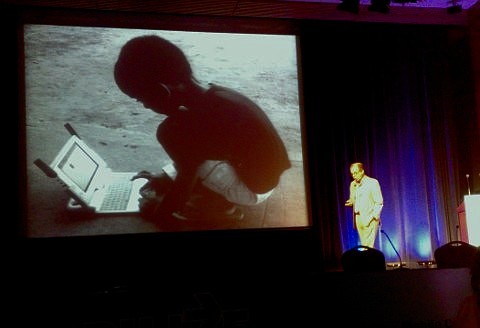
I heard Nicholas Negroponte speak at Mobilize today. It was a zinger of a talk. He started by saying that since its founding in 2001, One Laptop per Child’s goal has been to deliver enabling technology in and only in areas where market forces couldn’t or wouldn’t.
Although he started with laptops, Negroponte now believes that tablets are the best, most cost effective tool for enhancing learning everywhere in the world.
Negroponte’s described his ideal tablet as:
- Unbreakable
- Needs no external power, charged by shaking.
- Has cheap connectivity but useful without it, The Cloud isn’t essential. Negroponte gave the example of distributing 100 tablets with 100 books preloaded on each in a village. Even disconnected they instantly give the village 10,000 books, more than the average school library in the US.
- Uses a portrait rather than landscape display
- Transflective display, it’s the only display technology that works well with every level of ambient light
- Uses haptics for input feedback
He stressed the importance of design. We need designs that facilitate creating content. People learn best by doing, and creating rather than just reading. Calling Apple’s business model, “making peripherals for iTunes”, he said his is creating tools to unleash creativity in China, in Africa and everywhere.
I like Negroponte’s tablet concept; inexpensive, transflective screen, uses available connectivity but useful without it, favors creation over consumption. I also think the concept shares a lot with the way mobile phones are evolving. The OLPC tablet is a lot like a large but basic touch screen phone with a lean and efficient operating system. Whether or not it includes a cellular radio it could be built using a lot of mass produced mobile phone hardware and software, which thanks to volume, would help OLPC meet its low price goals.
The question is, who will build it. Negroponte was vague about if or when his tablet would be available. A prototype exists but he seemed wary of being a hardware vendor again and now sees his role as creating designs for others to build.
I’m with you in thinking that this would be great. The focus for his team to pull this off is pretty neat.
Sounds so much like the first few iterations of Nokia’s Maemo platform on the software side. There is much that I learned about open source educational software and how folks have built tones of stuff from scratch. I wonder of the next iteration of Sugar will male it easier for teachers to create and dissemenate content modules from the device.
The haptics end of this is so locked by IP patents that we can be sure that the US and several other countries will only see this in a very overpriced fashion.
Looking forward to this project. Heck, would love to play a role in developing it and associated software – could be fun.